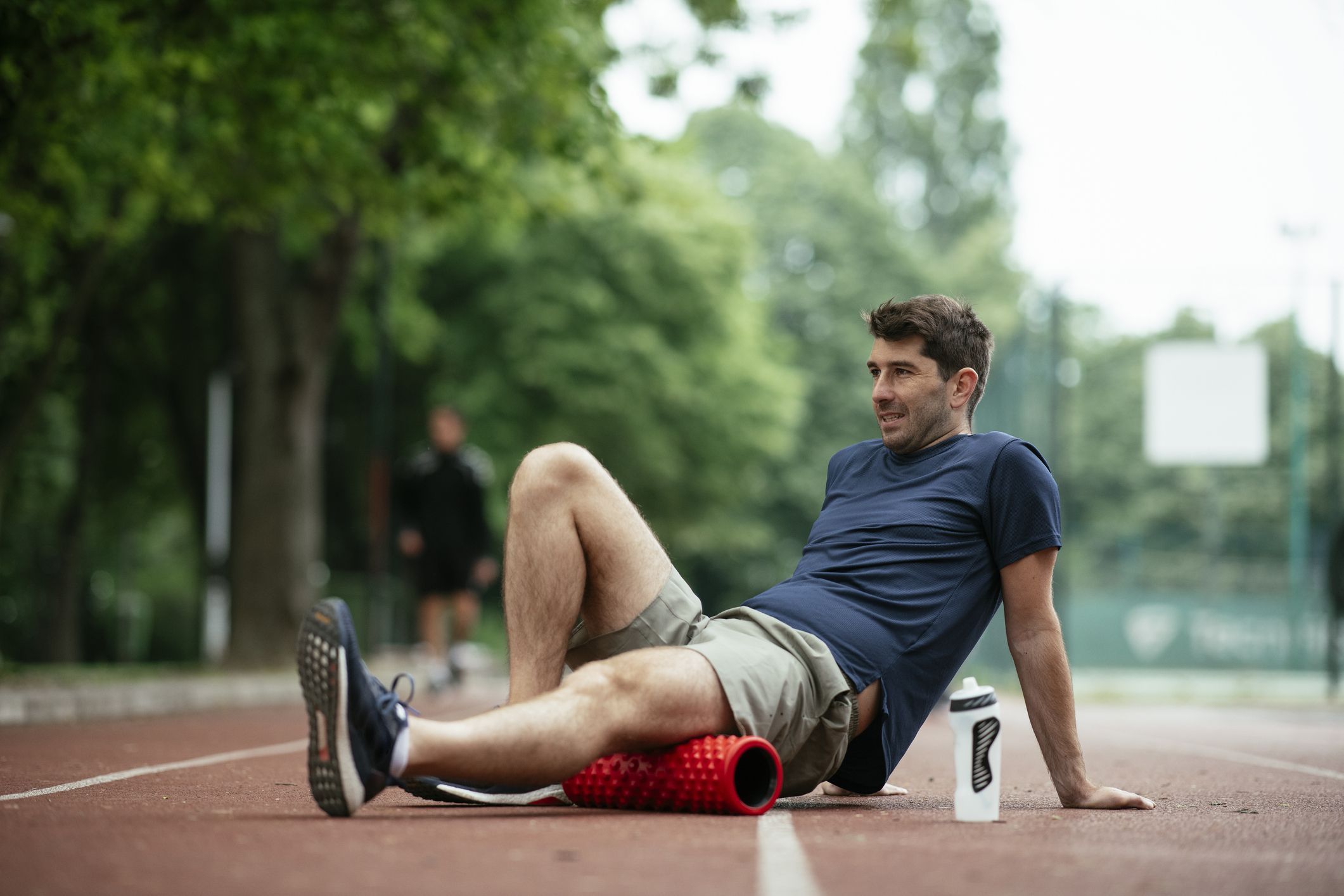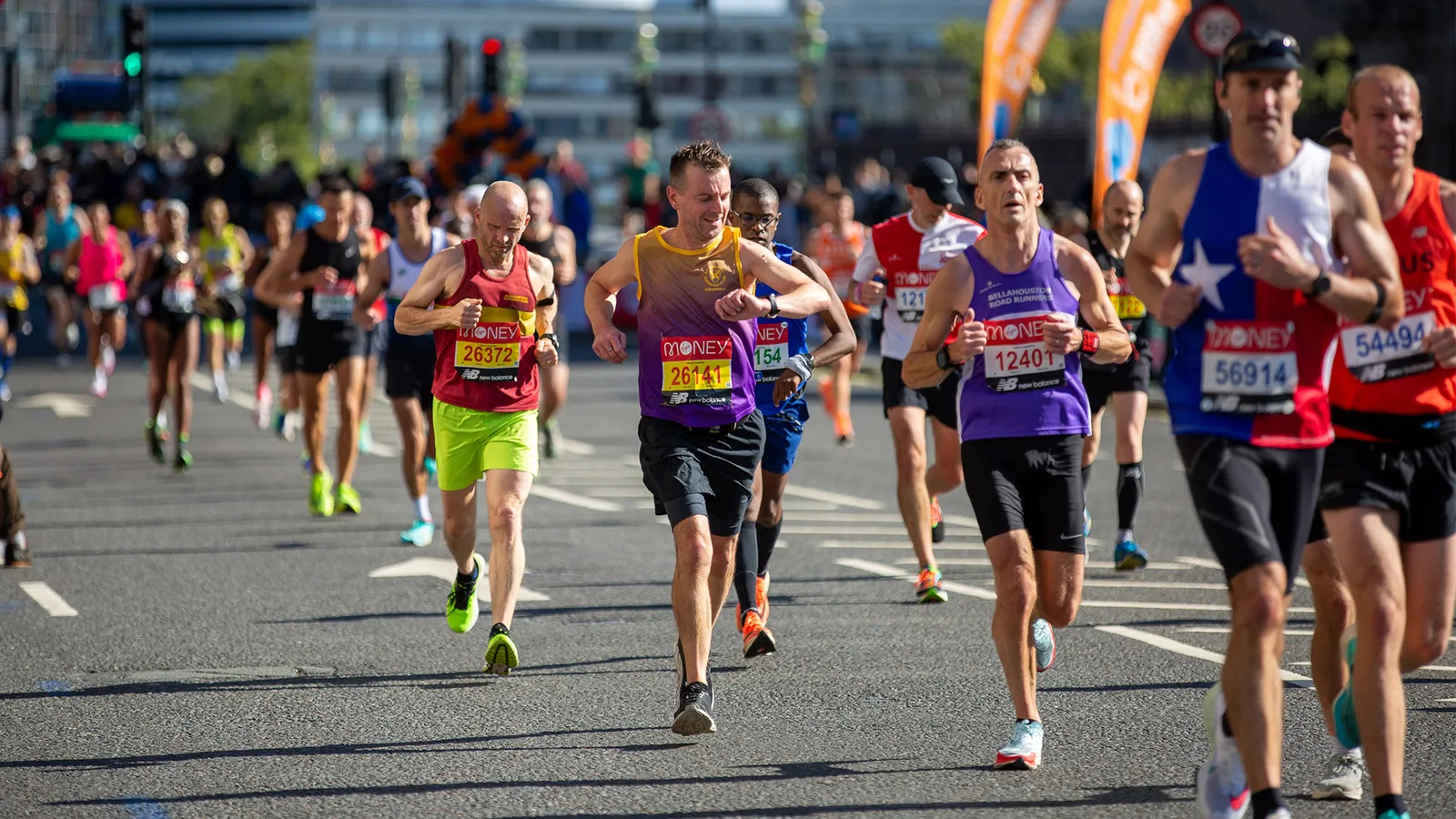

Featured
How To Run A Marathon
Modified: January 22, 2024
Learn how to run a marathon with our featured guide, packed with expert tips, training plans, and strategies for every level of runner. Start your marathon journey today!
Introduction
Welcome to the world of marathon running! Whether you are a seasoned athlete or a novice looking for a new challenge, completing a marathon is a remarkable achievement that requires dedication, discipline, and perseverance. Running 26.2 miles is a test of physical and mental strength, but with the right training plan, gear, and mindset, you can conquer this ultimate endurance race.
Before embarking on your marathon journey, it’s important to understand what you’re getting yourself into. A marathon is not just a physical feat; it’s an experience that will push you to your limits and make you discover strengths you didn’t know you had. It will require countless hours of training, sacrifices, and a commitment to your health and well-being. But rest assured, the rewards and sense of accomplishment you’ll feel when crossing that finish line will be truly life-changing.
In this comprehensive guide, we will explore the essential steps and strategies to help you successfully train for and complete a marathon. From setting up your training plan to crossing the finish line, we’ll cover every aspect of marathon running. Throughout this journey, remember that every runner is unique, and what works for one person may not work for another. It’s important to find what suits you best and make adjustments along the way.
So, whether you’re a first-time marathon runner or looking to improve your performance, let’s dive into the world of marathon running and equip you with the knowledge and tools you need to succeed.
Setting Up Your Training Plan
One of the most crucial aspects of marathon preparation is setting up a well-structured training plan that suits your fitness level and goals. A training plan serves as a roadmap, guiding you through the weeks and months leading up to the marathon. It ensures that you gradually build up your endurance, strength, and stamina while minimizing the risk of injury.
When designing your training plan, there are a few key factors to consider:
- Timeframe: Determine how many weeks you have until the marathon and divide it into phases. Generally, a marathon training plan lasts between 12 to 20 weeks, depending on your current fitness level.
- Mileage: Gradually increase your weekly mileage to build endurance. Start with a base mileage that is comfortable for you and add a few miles each week. However, avoid increasing mileage too quickly, as it can lead to overuse injuries.
- Rest Days: Incorporate rest days into your training plan to allow your body to recover and adapt to the physical demands. Rest days are just as important as training days as they prevent burnout and reduce the risk of injury.
- Long Runs: Include weekly long runs to build your endurance and mental toughness. Start with a distance that is manageable for you and gradually increase it each week. Aim to complete at least one or two runs that are close to or slightly longer than the marathon distance.
- Speed Work: Integrate speed workouts such as interval training, tempo runs, and hill repeats into your training plan. These workouts improve your running efficiency, speed, and anaerobic threshold.
- Cross Training: Supplement your running with cross-training activities like cycling, swimming, or strength training. They help build overall fitness, prevent muscle imbalances, and reduce the risk of overuse injuries.
- Listen to Your Body: Pay attention to how your body responds to the training plan. If you’re feeling excessively fatigued or experiencing pain, it’s crucial to rest or modify your workouts. Pushing through pain can lead to serious injuries.
Remember, a marathon is a long-distance event that requires proper preparation and gradual progression. Your training plan should be challenging yet realistic, allowing you to build up your fitness gradually and reduce the risk of burnout and injuries. Regularly assess and adjust your training plan based on your progress, fitness level, and overall well-being.
Now that we have covered the fundamentals of setting up your training plan, let’s explore the next crucial element for marathon success—choosing the right gear.
Choosing the Right Gear
When it comes to marathon running, having the right gear can make a significant difference in your performance, comfort, and overall experience. From your shoes to your apparel, here are some key factors to consider when choosing your marathon gear:
- Running Shoes: Invest in a pair of running shoes that provide the right support and cushioning for your feet. Visit a specialty running store to get fitted and find a shoe that suits your gait and running style. Remember, wearing worn-out shoes can increase the risk of injuries.
- Moisture-Wicking Apparel: Opt for moisture-wicking, breathable fabrics that help regulate your body temperature and minimize chafing. Choose clothing that fits comfortably without being too loose or restrictive.
- Socks: Invest in good-quality, moisture-wicking socks that provide cushioning and help prevent blisters. Avoid cotton socks as they retain moisture and can lead to discomfort and blisters.
- GPS Watch or Running App: Consider using a GPS watch or a running app on your smartphone to track your distance, pace, and other important data. This can help you monitor your progress and adjust your training as needed.
- Hydration System: Depending on your preference, choose a hydration system that works best for you. This may include handheld water bottles, hydration belts, or hydration vests. Staying properly hydrated during the marathon is crucial for performance and safety.
- Nutrition: Experiment with different energy gels, chews, or other forms of fuel during your training runs to find out what works well for you. Additionally, consider wearing a fuel belt or carrying a small pouch to store your nutrition during the race.
- Sunglasses, Hat, and Sunscreen: Protect yourself from the sun’s rays by wearing sunglasses, a hat, and applying sunscreen. These items can not only keep you comfortable but also help prevent sunburn and sun-related health issues.
- Compression Gear: Compression socks, sleeves, or tights can aid in muscle recovery and improve blood circulation. Some runners find that wearing compression gear during long runs or after training sessions helps reduce muscle soreness.
- Emergency Essentials: Carry a small first aid kit, identification, emergency contact information, and any necessary medications. While emergencies are rare, it’s always better to be prepared.
Each runner has their own preferences and needs when it comes to gear selection. It’s important to test and train with your gear ahead of time to ensure that everything fits properly and feels comfortable during long runs. Avoid making any last-minute gear changes or using new gear on race day to prevent discomfort or unforeseen issues.
Now that we have covered the importance of choosing the right gear, let’s move on to discuss nutrition and hydration strategies to support your marathon training and performance.
Nutrition and Hydration
Nutrition and hydration are key components of successful marathon training and performance. Fueling your body with the right nutrients and staying properly hydrated during your training and the race itself is crucial for energy levels, endurance, and overall well-being.
Here are some important considerations for nutrition and hydration during marathon training:
- Macronutrients: Ensure that your diet includes a balanced combination of carbohydrates, proteins, and healthy fats. Carbohydrates provide the primary fuel source for running, while proteins aid in muscle recovery and repair. Healthy fats are important for overall health and can help provide sustained energy. Aim to include whole grains, lean proteins, fruits, vegetables, and healthy fats in your daily diet.
- Pre-Workout Nutrition: Have a balanced meal or snack containing carbohydrates and a moderate amount of protein about 1-3 hours before your training runs. This will help top up glycogen stores and provide energy for your run.
- During-Workout Nutrition: Experiment with different forms of fuel such as energy gels, chews, or sports drinks during your long runs to determine what works best for you. Aim to consume around 30-60 grams of carbohydrates per hour during your runs to maintain energy levels.
- Post-Workout Nutrition: Consume a recovery meal or snack within 30-60 minutes of completing your longer training runs. This meal should include a combination of carbohydrates and protein to replenish glycogen stores and aid in muscle repair.
- Hydration: Hydrate adequately before, during, and after your training runs. Aim to drink water or a sports drink to replenish fluids and electrolytes. Pay attention to your urine color – a pale, straw-like color indicates proper hydration.
- Electrolytes: During longer runs, consider consuming electrolyte-rich fluids or taking electrolyte supplements to maintain proper electrolyte balance and support nerve and muscle function.
- Recovery Nutrition: Include a mix of carbohydrates and protein in your recovery meal or snack to facilitate muscle recovery and glycogen replenishment. This can include a combination of whole foods and certain recovery products.
- Consult a Professional: If you are unsure about your specific nutritional needs or have dietary restrictions, consult with a registered dietitian or sports nutritionist to ensure you are getting the right nutrients for optimal performance.
Remember, nutrition and hydration strategies are highly individualized, and what works for one person may not work for another. It’s essential to listen to your body and make adjustments based on your own needs and preferences. Practice your nutrition and hydration strategies during your training runs to fine-tune your approach for race day.
Now that we have covered the importance of nutrition and hydration, let’s move on to the building blocks of marathon training – building endurance and strength.
Building Endurance and Strength
When it comes to marathon training, building endurance and strength are critical factors that will contribute to your overall performance and help you conquer the 26.2-mile journey. By incorporating specific workouts and training techniques, you can improve your cardiovascular fitness, muscular endurance, and running economy.
Here are some key strategies to build endurance and strength for marathon training:
- Long Runs: Include regular long runs in your training plan to gradually increase your mileage and build endurance. Start with a distance that is manageable for you and progressively add mileage each week. Aim to complete at least one or two runs that are close to or slightly longer than the marathon distance.
- Hill Training: Incorporate hill workouts into your training routine to build strength and power. Find a hilly route or use a treadmill with an incline. Hill repeats and hill sprints are effective exercises to improve leg strength and running efficiency.
- Interval Training: Integrate speed workouts like interval training into your training plan. This involves alternating between high-intensity bursts of running and recovery periods. For example, you can run at a faster pace for 1 minute, followed by a 1-2 minute recovery jog. Interval training improves your aerobic capacity, anaerobic threshold, and overall speed.
- Tempo Runs: Incorporate tempo runs into your training plan to improve your lactate threshold and running economy. Tempo runs involve running at a comfortably hard pace for a sustained period, usually between 20-60 minutes. This helps enhance your body’s ability to maintain a steady pace over longer distances.
- Strength Training: Include regular strength training exercises to build overall strength, muscular endurance, and prevent injuries. Focus on exercises that target your lower body, core, and upper body. Squats, lunges, planks, and push-ups are great exercises to include in your routine.
- Cross-Training: Incorporate cross-training activities like cycling, swimming, or rowing into your training plan. These activities not only provide a break from running but also strengthen different muscle groups and improve overall fitness.
- Consistency and Progression: Consistency is key when it comes to building endurance and strength. Gradually increase your mileage and the intensity of your workouts over time to allow your body to adapt and improve gradually.
- Structured Recovery: Ensure that you incorporate rest days and recovery periods into your training plan. Rest allows your muscles to repair and rebuild, reducing the risk of overuse injuries and allowing for proper adaptation to training.
Remember, building endurance and strength takes time and consistent effort. It’s important to listen to your body, avoid pushing yourself too hard, and gradually progress your training. Don’t be discouraged by setbacks or plateaus. Your body will adapt and become stronger with time and proper training.
Now that we have covered strategies for building endurance and strength, let’s shift our focus to the mental preparation needed for marathon success.
Mental Preparation
When it comes to marathon running, mental preparation is just as important as physical training. The mind plays a critical role in pushing through the challenges and maintaining focus and determination throughout the 26.2-mile journey. Developing mental strength and resilience will help you stay motivated, overcome self-doubt, and push past your limits.
Here are some strategies to help you mentally prepare for the marathon:
- Set Clear Goals: Define your goals for the marathon. Whether it’s finishing within a certain time, enjoying the experience, or simply completing the race, having clear objectives will keep you focused and motivated during training and on race day.
- Visualize Success: Use visualization techniques to imagine yourself crossing the finish line, feeling strong, and achieving your goals. Visualizing success helps build confidence and creates a positive mindset.
- Positive Self-Talk: Replace negative thoughts and self-doubt with positive affirmations. Remind yourself of your capabilities, strengths, and the progress you’ve made during training. Use positive self-talk to stay motivated and confident throughout the marathon.
- Break the Race Into Smaller Segments: Instead of overwhelming yourself with the entire distance, mentally divide the marathon into smaller, manageable segments or milestones. Focus on one segment at a time and celebrate your accomplishments along the way.
- Practice Mindfulness: Incorporate mindfulness techniques, such as deep breathing or meditation, into your training routine. These practices can help calm your mind, reduce stress, and improve focus during training and on race day.
- Develop Strategies for Challenging Moments: Anticipate and prepare for challenging moments during the marathon, such as fatigue or hitting the proverbial “wall.” Develop specific strategies to overcome these obstacles, such as using a mantra, visualizing success, or focusing on your running form.
- Draw Inspiration: Surround yourself with sources of inspiration. Read books or blogs about marathon running, connect with fellow runners for support and motivation, or watch videos of successful marathon finishes. Drawing inspiration from others can help fuel your own determination and resolve.
- Practice Mental Toughness: During training, intentionally put yourself in challenging situations to practice mental toughness. Push through tough workouts, adverse weather, or fatigue to strengthen your mental resilience. This will prepare you to face and overcome challenges during the marathon.
- Stay Present: Focus on the present moment during the marathon. Avoid getting overwhelmed by thoughts of how much distance is left or how tired you may feel. Instead, focus on your breathing, your surroundings, and maintaining a steady pace.
Remember, the marathon is as much a mental battle as it is a physical one. Training your mind to stay resilient, positive, and focused will help you overcome the inevitable challenges you’ll face along the way.
Now that we have covered strategies for mental preparation, let’s explore the importance of injury prevention and recovery in marathon training.
Injury Prevention and Recovery
In marathon training, injury prevention and recovery are crucial aspects that should not be overlooked. Running long distances, especially during intense training, can put a significant strain on your body. Taking proactive measures to prevent injuries and allowing for adequate recovery time will help you stay healthy, perform at your best, and minimize the risk of setbacks.
Here are some key strategies for injury prevention and recovery:
- Warm-Up and Cool-Down: Prior to your runs, incorporate a dynamic warm-up routine to prepare your muscles and joints for the upcoming workout. After your runs, perform a cool-down consisting of gentle stretching to help relax your muscles and aid in recovery.
- Cross-Training: Incorporate cross-training activities into your training plan to strengthen different muscle groups and reduce the risk of overuse injuries. This can include activities like cycling, swimming, or strength training.
- Strength Training: Include strength training exercises to improve overall muscle strength and stability. Focus on exercises that target your lower body, core, and upper body. This will help balance muscle development and reduce the risk of imbalances and injuries.
- Listen to Your Body: Pay attention to any pain or discomfort during training. If you experience persistent pain, it’s important to rest or seek medical advice. Pushing through pain can worsen an injury and prolong the recovery process.
- Gradual Progression: Gradually increase your mileage and the intensity of your workouts to allow your body to adapt gradually. Avoid sudden jumps in mileage or intensity, as this can increase the risk of overuse injuries.
- Rest and Recovery Days: Incorporate rest days and easy recovery runs into your training plan. Rest allows your body to repair and rebuild, reducing the risk of overtraining and injuries. Use rest days as an opportunity for active recovery, focusing on techniques like foam rolling, stretching, or gentle yoga.
- Proper Nutrition: Fuel your body with a balanced diet that includes adequate protein, carbohydrates, and healthy fats. Proper nutrition supports muscle recovery and tissue repair, helping to prevent injuries and support overall health.
- Quality Sleep: Get enough quality sleep to aid in recovery and allow your body to heal. Aim for a consistent sleep schedule and create a sleep environment that promotes restful sleep.
- Professional Help: If you experience recurring or persistent injuries, consider seeking help from a healthcare professional or sports therapist. They can diagnose underlying issues, provide targeted treatments, and offer guidance on injury prevention and rehabilitation.
- Listen to Your Body: It’s important to pay attention to your body’s warning signs and not ignore any potential injuries. Taking the necessary steps to address these issues early on can prevent them from becoming more serious and affecting your training.
Remember, injury prevention and recovery should be an integral part of your marathon training plan. By taking the necessary precautions and allowing your body to rest and heal, you’ll be able to stay on track and perform at your best.
Now that we have covered strategies for injury prevention and recovery, let’s shift our focus to preparing for the big day – race day!
Race Day Preparation
Race day is the culmination of months of training and preparation. It’s an exciting and nerve-wracking time, but with proper race day preparation, you can set yourself up for success. From organizing your logistics to mentally priming yourself, here are some key steps to ensure you have a smooth and memorable race day:
- Know the Course: Familiarize yourself with the race course, including any elevation changes, aid stations, or key landmarks. This knowledge will help you mentally prepare and strategize your race.
- Organize Your Logistics: Plan your transportation to the race start, gather all necessary gear, and prepare your race bib and other required documents in advance. Minimize stress by having everything organized and ready to go the night before.
- Create a Race Day Checklist: Make a checklist of all the items you need to bring on race day, including your running shoes, apparel, hydration system, nutrition, and any other race essentials. Double-check the list to ensure nothing is forgotten.
- Stick to Your Routine: Adhere to your pre-race routine regarding meals, sleep, and hydration. Stick to foods that you have previously tried and are easily digestible. Avoid experimenting with new foods or drinks that may upset your stomach.
- Stay Hydrated: Begin hydrating the day before the race and maintain proper fluid intake on race day. However, avoid over-hydrating, as it can lead to discomfort or frequent bathroom breaks during the race.
- Check the Weather: Monitor the weather forecast leading up to race day. Dress appropriately for the conditions and adjust your race strategy if needed (e.g., pacing, hydration, and clothing choices).
- Arrive Early: Plan to arrive at the race venue with ample time before the start. This will allow you to go through the necessary race day procedures, such as checking your gear, using restrooms, and warming up.
- Warm-Up: Prior to the race, engage in a warm-up routine that includes dynamic stretches and a short jog to prepare your muscles and joints for the upcoming effort. This will help prevent injuries and improve your performance.
- Stick to Your Race Strategy: Stick to the race pace and strategy that you have trained for. Avoid starting too fast or getting caught up in the excitement of the race. Trust your training and execution plan.
- Maintain a Positive Mindset: Stay positive and focused throughout the race. Remember your training, visualize success, and draw on the mental strategies you’ve practiced to stay motivated. Break the race into smaller segments and celebrate each milestone.
- Run Your Own Race: Focus on your own journey and goals, rather than comparing yourself to others. Listen to your body and make necessary adjustments during the race, but remember to trust in the training and preparation you have put in.
- Savor the Experience: Take in the sights, sounds, and energy of the race day. Engage with the spectators, fellow runners, and volunteers. Remember to smile, enjoy the moment, and celebrate the incredible achievement of participating in a marathon.
By following these race day preparation steps, you can ensure that you are physically and mentally ready to tackle the marathon, making the most of your training and hard work.
Now that we have covered race day preparation, it’s time to explore what to expect during the marathon itself and how to stay strong until the finish line.
During the Marathon
The marathon is a grueling yet exhilarating experience that will put your months of training to the test. During the race, it’s important to stay focused, motivated, and resilient. Here are some tips to help you navigate through the marathon and stay strong until the finish line:
- Stick to Your Race Plan: Trust the pacing and strategies you’ve practiced during training. Avoid the temptation to start too fast or get carried away by the energy of the race. Pace yourself and conserve energy for the later miles.
- Hydrate and Fuel: Make use of the aid stations along the course to stay properly hydrated. Take sips of water or sports drinks as needed, and consume your planned nutrition at regular intervals. Listen to your body’s cues for when to fuel and hydrate.
- Maintain Proper Form: Focus on maintaining good running form throughout the race. Keep your head up, shoulders relaxed, and stride efficient. This will help prevent unnecessary strain and fatigue on your muscles.
- Break the Race into Smaller Segments: Mentally divide the marathon into smaller, manageable segments. Focus on one mile or one landmark at a time. Celebrate each segment as you accomplish it, keeping you motivated and focused on the task at hand.
- Draw on External Support: Engage with the spectators and fellow runners during the race. Their cheers, encouragement, and support can provide an incredible boost of motivation when you need it the most. Acknowledge and appreciate their presence.
- Manage Mental Fatigue: As the miles add up, it’s normal to experience mental fatigue and doubt. Use positive self-talk, affirmations, and visualization techniques to stay positive and motivated. Focus on your reasons for running the marathon and draw strength from your training and preparation.
- Be Flexible and Adapt: Adjust your race strategy if needed. If the weather conditions or your physical state change unexpectedly, be adaptable and make necessary adjustments. Be prepared for unforeseen circumstances and trust yourself to make smart decisions.
- Breathe and Relax: Take deep breaths and consciously relax your muscles during the race. This can help release tension and reduce fatigue. Focus on maintaining a steady breathing rhythm to find your rhythm and stay centered.
- Be Mindful of Your Body: Pay attention to any pain, discomfort, or signs of fatigue during the race. If you need to, take short walk breaks or slow down to recover. Listen to your body’s needs and adjust your pace or effort accordingly.
- Stay Positive and Grateful: Embrace the challenges and tough moments during the marathon. Maintain a positive mindset and remind yourself of the privilege it is to run a marathon. Express gratitude for the experience and for your ability to participate.
- Stay Strong and Never Give Up: Remember that you are capable of achieving your goal. Stay mentally strong, push through tough moments, and never give up. Trust in your training and believe in yourself until you cross that finish line.
By employing these strategies during the marathon, you can conquer the distance and experience the incredible sense of accomplishment that comes with completing a marathon.
Now, let’s move on to the final section where we celebrate the moment of crossing the finish line.
Crossing the Finish Line
Crossing the finish line of a marathon is a momentous occasion filled with a sense of achievement, pride, and overwhelming emotions. As you approach the final stretch of the race, keep these tips in mind to make the most of your finish line experience:
- Enjoy the Moment: Take in the sights, sounds, and energy as you approach the finish line. Celebrate the journey and the hard work you’ve put into training for this moment.
- Give it Your All: Dig deep and find that extra burst of energy for a strong finish. Empty your tank and leave everything on the course.
- Soak in the Atmosphere: Listen to the cheers from the crowd and the race announcer. Allow their words of encouragement to inspire and motivate you. Engage with the spectators and fellow runners around you.
- Smile and Celebrate: Smile as you cross the finish line, knowing that you’ve accomplished something incredible. Raise your arms in triumph, hug your loved ones, and revel in the moment.
- Collect Your Medal: Once you’ve crossed the finish line, collect your well-deserved finisher’s medal. This tangible symbol represents your accomplishment and will serve as a cherished memento of your marathon journey.
- Recovery and Rehydration: After finishing, prioritize rehydration and recovery. Drink water or sports drinks, and replenish your body with carbohydrates and protein through snacks or a meal. Take time to stretch and cool down your muscles.
- Reflect on Your Achievement: Take a moment to reflect on the training, dedication, and hard work that led you to this moment. Appreciate the progress you’ve made, the lessons you’ve learned, and the person you’ve become as a result of your marathon journey.
- Capture the Moment: Ask a friend, family member, or race volunteer to take a photo of you at the finish line. These photos will serve as a lasting memory of your accomplishment.
- Celebrate with Loved Ones: Find your family and friends, or join the post-race celebration area. Embrace them, share your joy, and express gratitude for their support along your marathon journey.
- Take Time to Recover: Your post-race recovery is just as important as the race itself. Listen to your body and take the necessary time to rest and recuperate. Reflect on your experience, set new goals, and decide on your future running endeavors.
Crossing the marathon finish line is an unforgettable moment that signifies your dedication, perseverance, and achievement. Embrace it, relish in your accomplishment, and be proud of what you have accomplished. You are now a marathoner!
Congratulations on completing the marathon, and best of luck on your future running endeavors!
Conclusion
Completing a marathon is an incredible achievement that requires dedication, discipline, and mental and physical strength. Throughout this comprehensive guide, we’ve explored the essential steps and strategies to help you successfully train for and complete a marathon.
We started by setting up your training plan, emphasizing the importance of gradually building mileage, incorporating rest days, and focusing on long runs and speed work. Choosing the right gear, including proper running shoes, moisture-wicking apparel, and hydration systems, is crucial for a comfortable and successful marathon experience.
Nutrition and hydration play a vital role in marathon training and performance. Fueling your body with the right macronutrients, consuming fuel during long runs, and staying properly hydrated are key for maintaining energy levels and supporting endurance.
Building endurance and strength through long runs, hill training, speed workouts, and cross-training is essential for a successful marathon journey. Mental preparation is equally important, as it helps you develop the resilience, focus, and positive mindset needed to overcome challenges during the race.
Injury prevention and recovery strategies, such as warm-ups, cross-training, strength training, and listening to your body, are crucial for staying healthy and avoiding setbacks during training and on race day.
When it comes to race day, proper preparation includes knowing the course, organizing logistics, maintaining routine, and staying mentally strong throughout the marathon. And finally, crossing the finish line is a moment to savor, celebrate, and reflect on the incredible journey you’ve undertaken.
Remember, each marathon experience is unique, and what may work for one person may not work for another. Adapt and personalize these strategies to suit your needs, listen to your body, and enjoy the process.
Now armed with the knowledge and tools outlined in this guide, you are ready to embark on your marathon journey and cross that finish line. Embrace the challenge, stay focused, and believe in yourself. The finish line awaits, and the sense of accomplishment that comes with completing a marathon is truly life-changing.
Best of luck on your marathon adventure, and may you enjoy every step of the journey towards becoming a marathoner!









